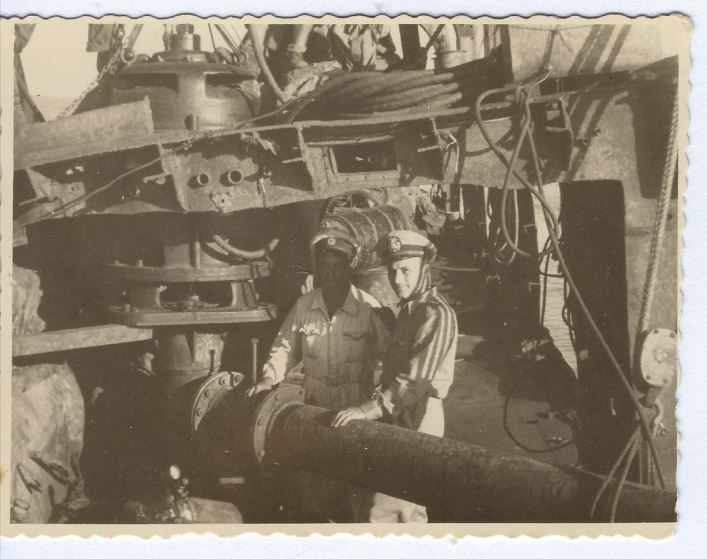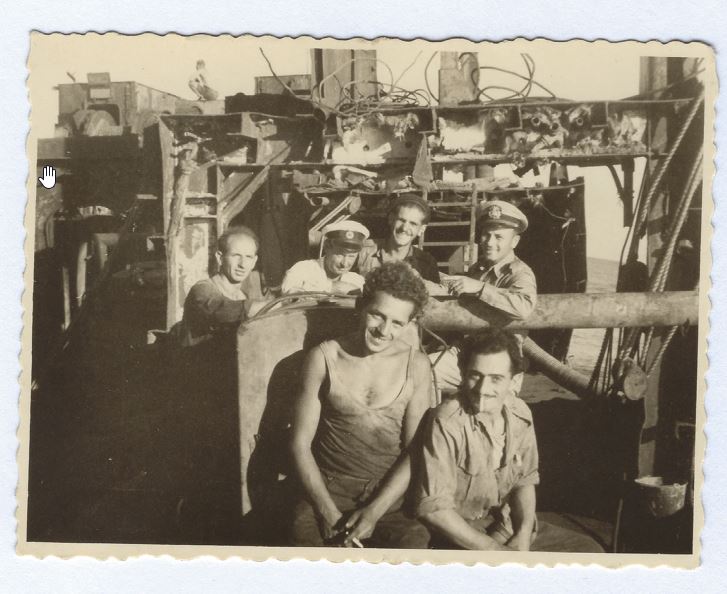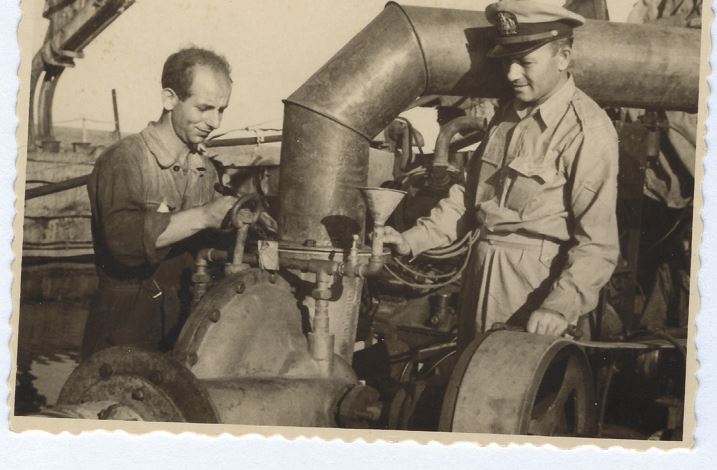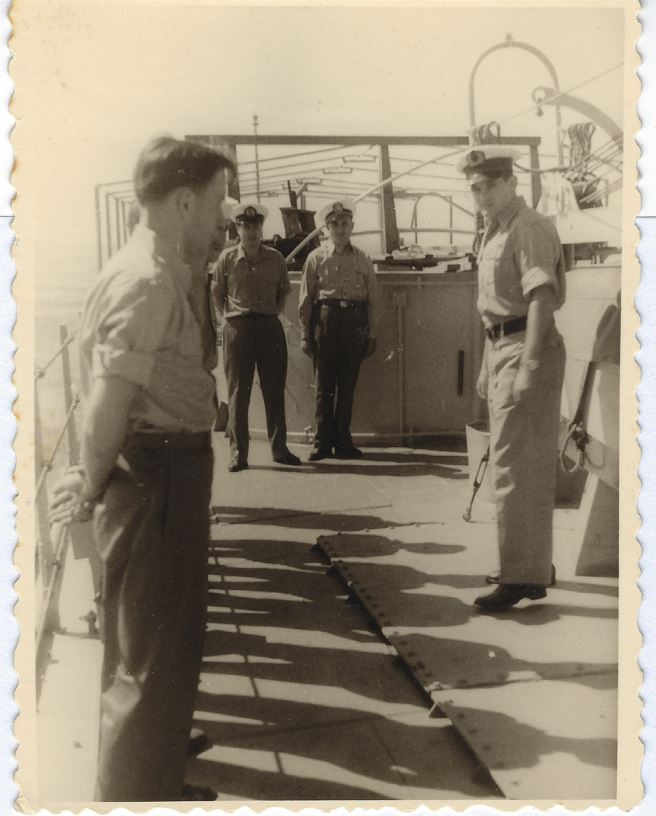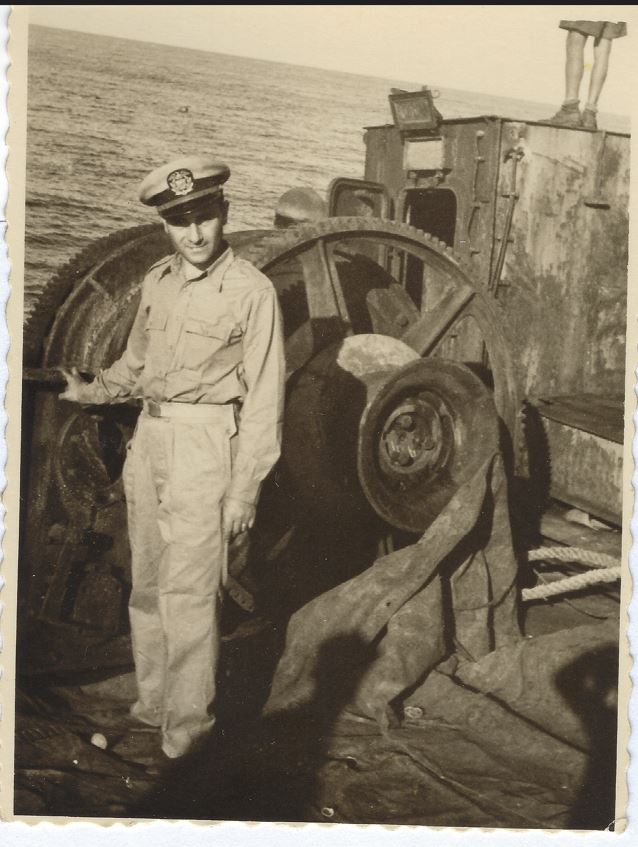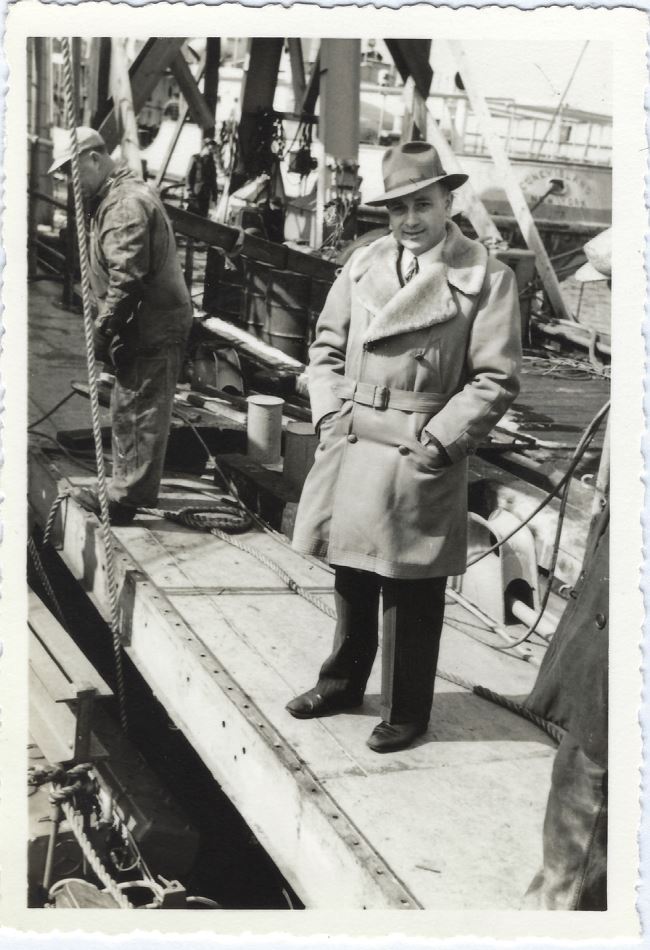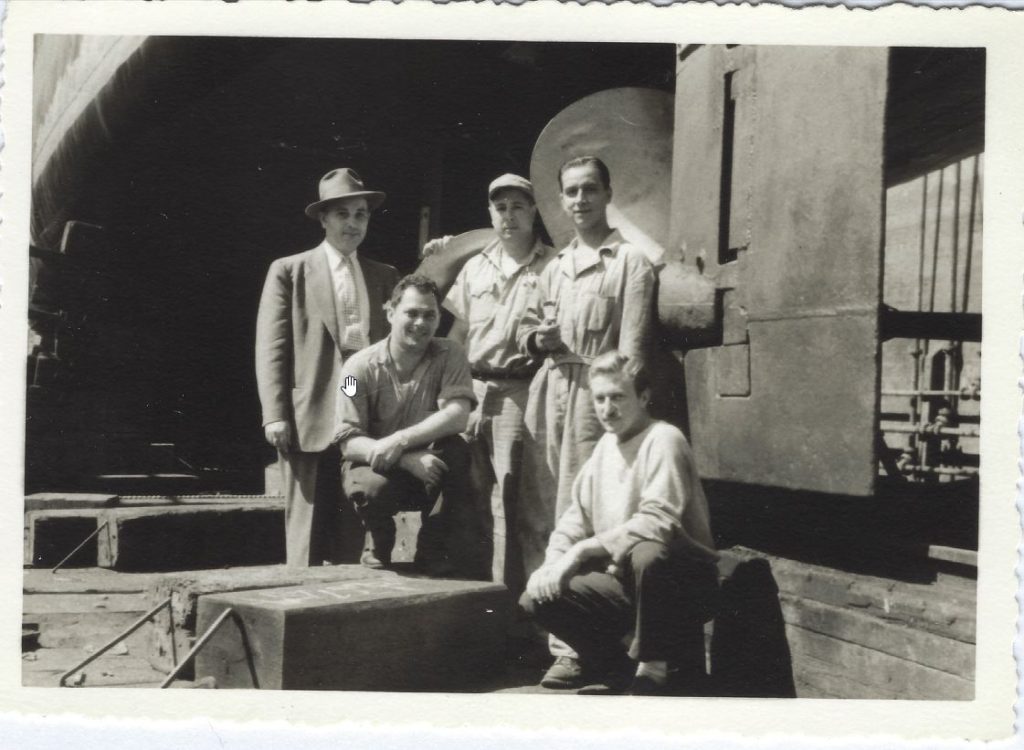Editor: in June 2022 we received many photos and records from Barry Halpern whose father the late, US Naval Reserve Commander Benjamin Halpern was a member of the Aliya Bet and Machal. Several of these are added to this page below. See separate page on the personal story of Benjamin Halpern.
David Hanovice
These are memories of the delivery of the “Yucatan,” renamed “Noga” K-26, in service during the 1948/49 Israel War of Independence. In June 1948 I graduated from the School of Technology of the University of Houston as an automotive and diesel technician, after serving overseas in the U.S. Army during World War II from February 1943 to January 1946.
As I was about to graduate from my studies, I planned to travel to Israel to participate in the Israel War of Independence that had begun just prior to my graduation. My application for a passport to travel to the war-stricken area in the Middle East was denied by the State Department, but I was determined to travel to Israel anyway. I obtained a U.S. Coast Guard seaman’s card to enable me to work my way on a merchant steam ship going to the Mediterranean if need be. I communicated with the Israeli student organization managed by Teddy Kollek under the auspices of the Supply Mission of the Jewish Agency in New York. My application was referred to Nat Cohen, then an agent of the maritime section, and very soon after that I was directed to join the MV “Yucatan” berthed at the Todd’s Shipyard in New Orleans, Louisiana. I reported on board on 1st July 1948.
The “Yucatan” was undergoing repairs to its Hamilton main engines, Buda generators and other machinery in preparation for the expected ocean crossing. Naturally, all this was supposed to be hush-hush and nobody knew anything about our destination. The MV “Yucatan,” an ex-U.S. Navy PC, 1265, a submarine chaser with service during World War II, was purchased by an undercover underground Jewish organization and scheduled for delivery to the Israel Navy, which was then in its infancy. The captain, Benny Berg, was in charge.
There was a mixed crew of some American merchant seamen, some returning Israeli students and American and Canadian volunteers. The MV “Yucatan” was registered under a Panamanian flag as a merchant ship, with captain, mates, and chief engineer licenses as the law and insurance required. In all there were 17 officers and crew members. These included Captain Ben Berg, Mates Louis Malik and Jonathan Leff, Jacob Teichman (now Nachlieli) and Canadian Jack Fox, Merchant Marine Radioman Lopez, Steward and Cook Steward Manuel, Mess boy and Steward’s helper Nathan Mossaief (now Massi), Chief Engineer Dan Bailey, First Engineer Ben Hagai Steuerman, Oiler day workers Abraham Mandelberg and David Hanovice.
After reporting on board, barely learning our way around and getting acquainted with the machinery, we attempted to leave the dock for testing the navigation, radar equipment and compasses on board. With a new deck crew at the helm, new engineers and engine crew, it became a trial-and-error exercise that turned into a fiasco.
There were too many bells for maneuvering in a tight space. With only one or two air-compressors in working condition we were soon adrift, having used up all of the reserve compressed starting air pressure to fulfill the unending maneuvering bells. We drifted in the Mississippi River for only a few hundred feet until a U.S. Navy ship came to our assistance.
On 4th July, although not all the repairs to the vessel had been completed, or missing machinery replaced, we were on our way to Vera Cruz, Mexico, our destination due to Washington’s unexpected changes in political attitudes towards the activities of Israeli underground organizations. We took on supplies and diesel fuel to enable our vessel to reach the port of Marseille, France.
While en route to Vera Cruz, I had a chance to make use of my training at the School of Technology of the University of Houston. One of the generators under repair at Todd shipyard in New Orleans was not in working order. I asked the chief engineer why we were not using the other generator to service the generator that was online all along. The chief engineer said that it would be repaired as soon as we arrived in port. I asked permission to check out that non-functioning generator and found the source of the problem. On board I found parts discarded by the shipyard, and using them I was able to rebuild the governor of the Bush unit fuel injection pump, start the generator, and put it online, and service and repair the second generator properly before we reached port.
We arrived at Vera Cruz on 6th July 1948. Two additional crewmembers joined our ship from one of the other clandestine ships in Mexico at that time. These were deck officer, U.S. Coast Guard licensed Mate Bernie Marks (an ex-U.S. Navy veteran of World War II), and Sidney Weinhaus (an ex U.S. Navy veteran of World War II) who served as second electrician.
While in Vera Cruz our fuel tanks were topped-up and we received some spare parts for the machinery and ship’s provisions and supplies. Several hundred 50-gallon diesel fuel drums were stored in every available empty storage compartment on board and on the main deck, with double layers of drums throughout the main deck area. All drums were properly lashed to prevent any losses overboard on rough seas; there were also catwalks and lifelines installed to enable the ship’s crew to get around safely on deck. All these measures took about five days to complete.
On or about 12th July 1948, as the Yucatan was ready to leave port, two of the merchant seamen acting as watch engineers got drunk and quit their jobs. As we were leaving port Chief Engineer Dan Bailey appointed me and the other oiler as acting watch engineers. I became acting second assistant engineer, the “Oil King.” One of my duties, beside standing watches of four hours twice daily, was transferring diesel fuel from the 50-gallon drums stored all over the ship. I used hoses and low air pressure to push the diesel oil by the use of a jury rig to one of the ship’s storage tanks.
As we were sailing in the Gulf of Mexico eastward, just before passing Cuba, one of the main engines broke down and the chief engineer requested that we go to a shipyard in Havana for repairs. Though we arrived there on the weekend, the shipyard immediately began work on the repairs.
While in the shipyard in Havana, our crewmen had time off and we all had a good time for three-four days. It seemed like a seaman’s paradise. Then we sailed out of Havana eastward towards Gibraltar. The Atlantic was mostly calm and as we approached Spain, one of our reduction gear’s lube oil coolers sprang an internal leak and the seawater contaminated the supply of lube oil to that gear. We did not have a lube oil purifier in working order, so the main engine had to be secured to avoid damage to the reduction gear.
We needed about 300 gallons of marine-type lube oil to replenish the reduction gearbox system. The nearest port where we could acquire that quantity and type of lube oil was Lisbon, Portugal. We sailed northward to Lisbon and again arrived there on the weekend. The supply agent could not get the lube oil supply right away, so we were at anchor in the port area for several days. Members of the ship’s crew who were not on duty were permitted go ashore. We attended a bullfight at the municipal arena with all the glitter one sees in the movies.
On or about August 8th 1948, we set sail for the Straits of Gibraltar and passed through them at full speed of 18 knots. Following the coast of Spain northward, we came upon “The Lion’s Gulf” and for the rest of the voyage to Marseille, France, we were in the midst of a terrible storm and making little headway. The ship was rolling over 40 degrees to each side; everyone on board was as sick as a dog.
On or about August 18th we finally arrived in the port of Marseille during a reprieve in the fighting in Israel. Due to League of Nations policing the temporary stop of hostilities in and around Israel and the Arab countries, we were not able to sail for Haifa immediately.
While waiting in Marseille, all of the American merchant seamen, including Captain Ben Berg, Chief Engineer Dan Bailey, First Assistant Engineer Ben Hagai Steuerman and Bernie Marks transferred to another ship. The other volunteers continued with the “Yucatan” to Haifa. We entered dry dock for inspection, where they repaired the storm damage and overhauled both main engines before sailing to Haifa. Ben Halperin joined the ship as chief engineer and also managed it as the ship’s agent. He knew his way around and spoke French fluently. I was appointed to work with the shipyard technicians, supervise and assist in the overhaul of the main engines and other engine room repairs, supplying them with needed spare parts from the ship’s inventory. Volunteers from among Jewish displaced persons from camps around Marseille, who were awaiting transportation to Israel, performed some of the ship’s maintenance work.
On or about September 20th the ship was given the okay to sail, and a captain of the Israel Merchant Fleet and some other officers and crew were sent from Israel to complement the crew in delivery of the “Yucatan” to Haifa. The new crew included Captain Johnny Turtle, Chief Mate Norbert, Bosun Walter Michaelis, Steward-cook Janosh and Israel Merchant Marine Engineer Gideon. The remaining Yucatan volunteers were Mate Louis Malik, Mate Jonathan Leff, Seamen Danny Landau, Jacob Teichman (Nachlieli), Jack Fox and Steward’s assistant Mess Boy Nathan Mosaief (Massi). Other crewmen were Chief Engineer Ben Halperin, acting First Assistant Engineer David Hanovice, acting Second Assistant Engineer Abraham Mandelberg, and Chief Electrician Sidney Weinhaus.
Volunteer crew from the displaced persons camp in Marseille included Mae Abraham Pezaro, Deckhand Charlie Bortz (“The Paratrooper”), and another deckhand. Serving in the Engine Department were engine day worker Martin Gross, as well as David Katz and Bernard Kassan.
On or about September 22nd 1948, we sailed from the port of Marseille. On our way to Haifa, as we entered international waters, there was a flag-raising ceremony on board. The Israeli flag was raised for the first time and the ship was renamed MV “Noga.” I was given the honor of raising the flag. During the voyage to Haifa, we encountered a severe storm in the eastern Mediterranean. The ship’s Steward-cook Janosh became sea-sick and could not feed the crew. One of the mates, Abraham Pezaro, took charge of the galley for about five days and did a very good job. We arrived in the port of Haifa on September 29th, 1948.
Upon arrival there was a joyous welcome. Many Israeli government and navy officials came on board as soon as we docked and welcomed and thanked each of the crew members. After immigration and custom inspection we were able to go ashore. The following day was payoff for the delivery crew. The MV “Noga” was handed over officially on September 30th 1948 to the Israel Navy, becoming K-26. Navy officers and crew members of various ratings started coming on board to establish naval routine and security for the newly commissioned K-26. At the same time, shipyard crews and naval ordinance experts came on board to outfit the K-26 with communication and other equipment, anti-aircraft guns and a naval cannon at the bow, depth charge racks at the stern deck, upgrading the original radar and checking the possibility of reactivating the sonar equipment. A complete inventory of equipment, spare parts, materials, and provisions was taken, and the shore gangs worked around the clock. The resumption of warfare was imminent and the K-26 was expected to take an active part.
While this was going on, we had a daily parade of potential replacement engine department crew. Many came, but very few wanted to stay. All kinds of reasons were given: The ship was too small and crowded, the engine room had too many machinery controls and alarms and was too complicated, as well as other unmentionable reasons. Meanwhile, Chief Engineer Ben Halperin was due to return to the U.S.A., but could not leave until there was a relief chief engineer. He recommended that I take over the position so that he could return home.
As I was not a licensed marine engineer and had only about three months of maritime and marine engineering experience, I didn’t feel competent enough to fill that position and responsibility, although I was able to operate and repair the ship’s machinery and handled the engine crew. The K-26 outfitting was completed in less than 10 days. We were ordered to stay for several weeks and I was pressured by Paul Shulman, then chief of staff of the Israel Navy, and his second-in-command Moca Limon, to stay and join the Israel Navy on the K-26 as a replacement for Ben Halpern when he left.
All of our newly-arrived volunteers who eventually remained to serve in the Israel Navy were sworn in at the Bat Galim Naval Base and returned to the K-26. Soon enough the K-26 participated in all of the naval engagements that took place in the 1948/49 War of Independence. We had a crew of about 70 officers and crew members, many of whom were Machalniks who had served in World War II in the Allied Armed Forces and Navies.
I will not attempt to name all of the new crew, but can give a partial list:
Captain – Oscar “Jock” Epstein; Chief Mate – Abraham Pezaro (Machal Holland); Mate – Yekotiel Pick (Netz); Mate – Yochanan Cohen; Radar Technician – Gerald Cohen (Machal U.S.A.); Ship’s Medic – Arthur Braver (Machal U.S.A.); Gunnery Officer – Charlie Mandelstam (Machal South Africa); Supply Officer Mircha, Bosun – Aaron Cohen (Machal U.S.A.); Chief Engineer – Ben Halperin (Machal U.S.A.); Assistant Engineer – David Hanovice (Machal U.S.A.); Assistant Engineer – Bernard Rose (Machal UK); Assistant Engineer Moshe Spector; Assistant Engineer Gad Avni; Junior Engineer Martin Gross (day work – Machal U.S.A.); Chief Electrician – Sidney Weinhaus (Machal U.S.A.); Second Electrician Moshe Schaumberg; Oiler – Bernie Kassan (day work – Machal U.S.A.); and other crew members of various ratings and duties.
As the hostilities of war resumed, the K-26 participated in all naval engagements and we were also attached to Shayetet 13 [Navy Seals]. On October 22nd 1948 Yochai [Ben-Nun, head of the Palyam in Haifa. Later, Commander in Chief of the Navy] was to be lowered from our deck for action to sink the Egyptian flagship the “Emir Farouk.” I was called up from the engine room to operate the deck crane to lower Yochai with his boat over the side to the water so that he could get onto his mission. Ben Halperin and Captain Jock Epstein left a few weeks later. Chief Mate Abraham Pezaro was appointed Captain of the K-26 and I was promoted to Chief Engineer. On October 10th I became a member of the Israel Defence Forces, with a commission as “hovel” [first officer] in the Israel Navy.
Throughout my service as chief engineer on the K-26, my engine department was always on ready-to-sail status and in top mechanical condition. The engine crew and I performed most of the maintenance and repair work, at times because of emergencies like breakdowns at sea, or alongside the dock with or without assistance of the naval machine and repair shop at the navy piers within the Haifa port area. Even after the hostilities ended we were out on patrol missions most of the time, except for occasional port calls to fuel up, acquire provisions and crew changes. After a while, the engine department on the K-26 became a training center for engine personnel of all ratings. Engineers, engine cadets and oilers were sent for various periods of time or on voyages. As soon as I was getting them to the point that I could benefit from their training, they were reassigned to other ships of bases and new ones came instead. It was hard work I put into those young men. In addition, I had to be on the lookout that because of the continuous crew turnover, there was no damage done to machinery, no one got hurt and that we were in operating condition ready to sail when called upon at any time.
In the K-26 engine room there were 2 marine-type Hamilton main engines of 1700 HP each, 10 cylinder two- cycle double acting supercharged diesels, air- started direct reversible engines, with an hydraulic clutch and Westinghouse reduction gear for each, with twin propellers. There were also a complement of two Buda generators and other auxiliaries to accommodate the ship’s operational requirements and comfort for the crew.
After a year of service on the “Yucatan” K-26, on July 21st 1949, my discharge came through and I returned to the United States to continue my studies. Although the K-26 was then in good operating condition, it came to a standstill and never sailed again on its own power due to the lack of competent engineering officers on board. Eventually the K-26 became a hotel-service and electric power supply mother ship for the small boat fleet at the naval southern section of the breakwater within the port area of Haifa. Years later, when the steel hull of the K-26 deteriorated, it was used for torpedo target practice and was sunk. It ended up at the bottom of the Mediterranean Sea, near Israel’s coastline.
The K-26 was a fine ship. As a former crew member who delivered and operated her for a year during a very difficult time for the State of Israel and the up-building of the Israel Navy, I hated to see her end up the way it did.
My service on the “Yucatan” and in the Israel Navy on the K-26 motivated me to choose ship repairs and marine engineering as my profession for the rest of my productive years of employment, which involved me in over 14 years in various ship repair shops. Then sailing as a U.S. coastguard licensed marine engineer in all ratings from Third Assistant to Chief Engineer in various types and sizes of bulk, cargo, tankers, and container ships for 22 years, till retirement at age 65.
From December 14th 1949 to July 18th 1950 I worked for the Government of Israel Defense Division of Supplies, Marine Department, in New York under the direction of Ben Halpern in the refitting of the “SS Violetta.” She was a surplus World War II Canadian Corvette 5000 HP twin screw at the Todd shipyard in New Orleans. I participated as a crewmember in her delivery to Haifa to become Israel Navy K-28.
Again I was called upon by Ben Halpern from June 16th 1951 to August 30th 1954 to assist in the conversion and delivery of the PC 1188 MV “Snonit” (a sister ship to the Yucatan) to Haifa to become Israel Navy K-22 that became part of Shayetet 13 operation. After the delivery of the K-22 I remained in Haifa for almost a year to train navy crews in the operation and maintenance of the newly converted engine room of that ship, with twin marine-type main propulsion Daimler Benz 20 cylinder V type 4 cycle diesel engines, 2500 HP each.
It gives me great satisfaction and pride to have actively participated in the Israel War of Independence and have had a share in the creation of the State of Israel and a homeland for the Jewish people.
Source: AVI (American Veterans of Israel) Newsletter: Spring 200149
These pictures were provided by Barry Halpern from his late father US Naval Reserve Commander Benjamin Halpern in June 2022. The pictures had the name Yucatan written on the back.
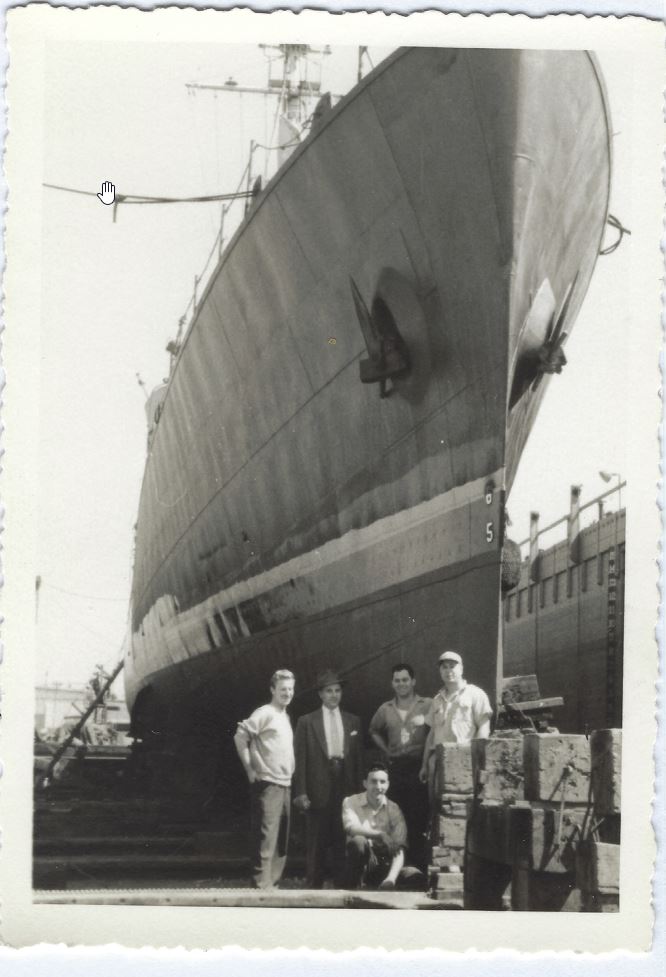
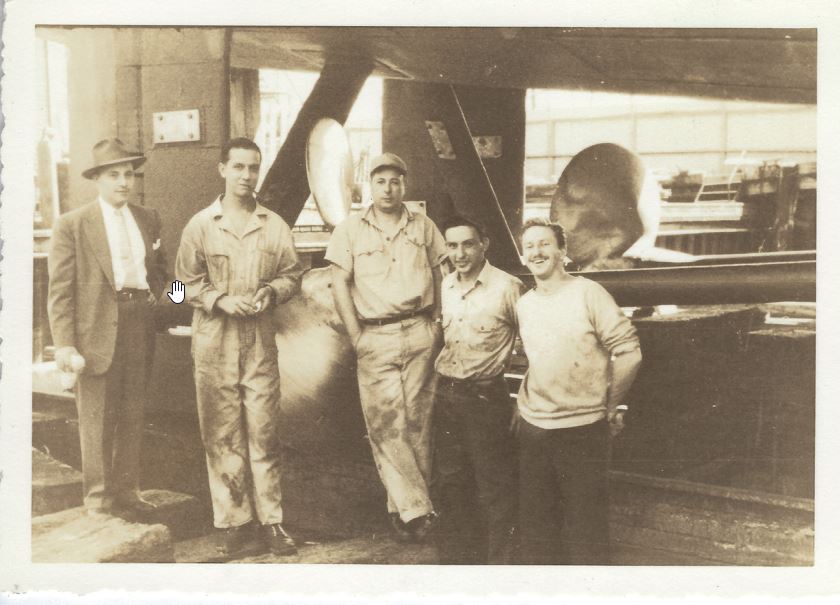
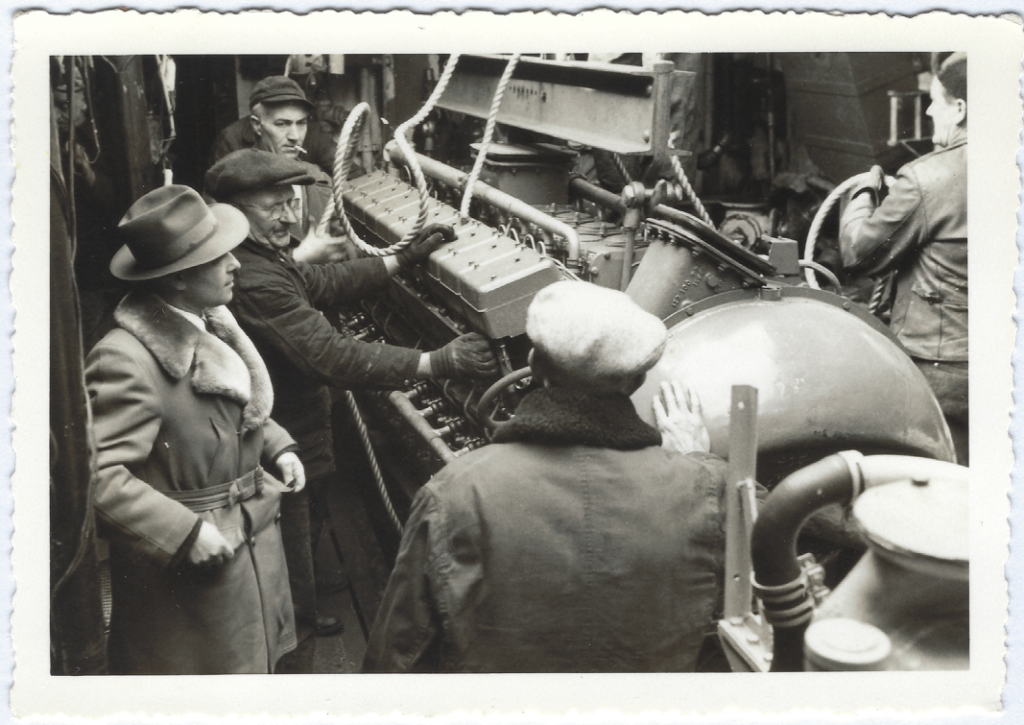
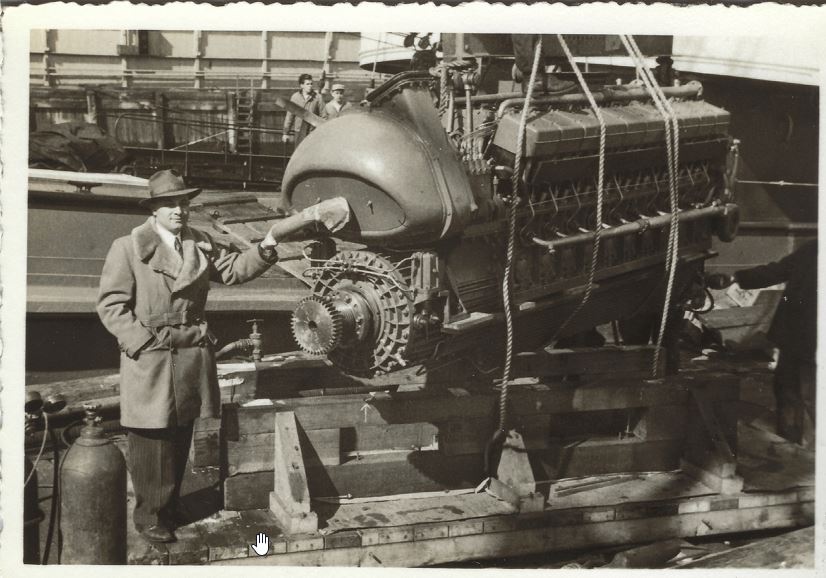
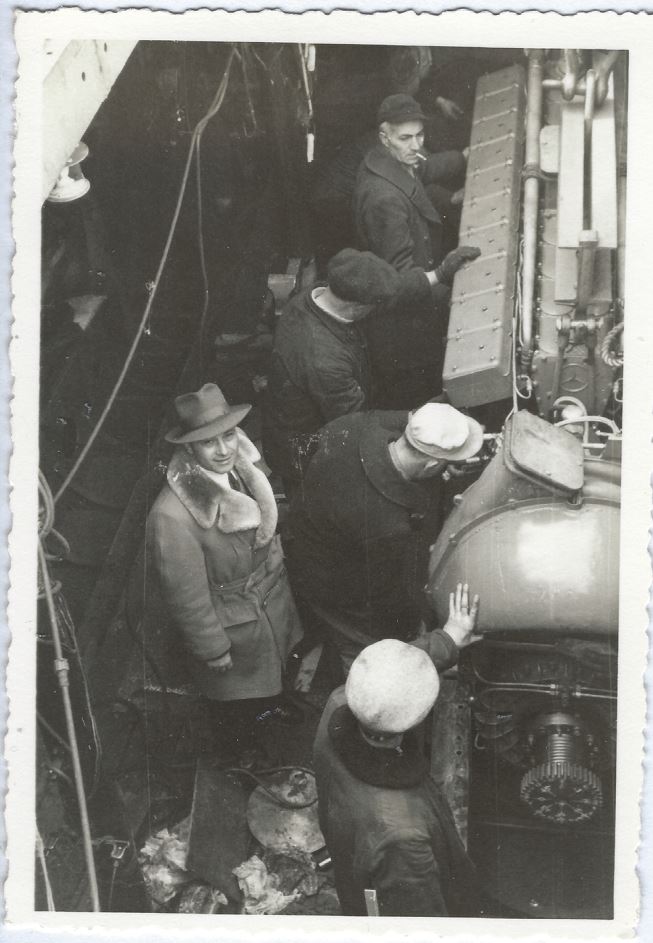
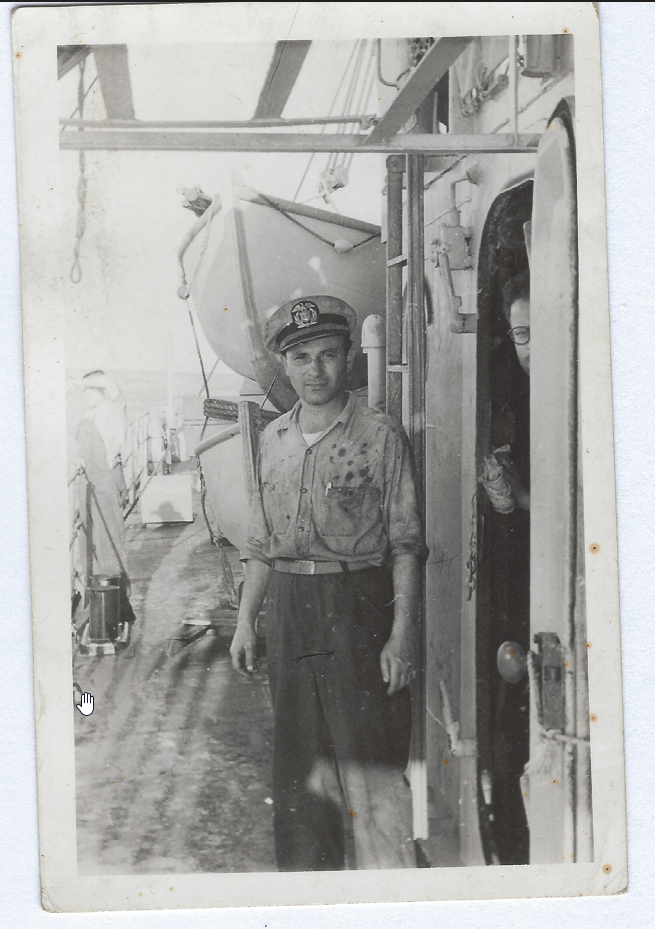
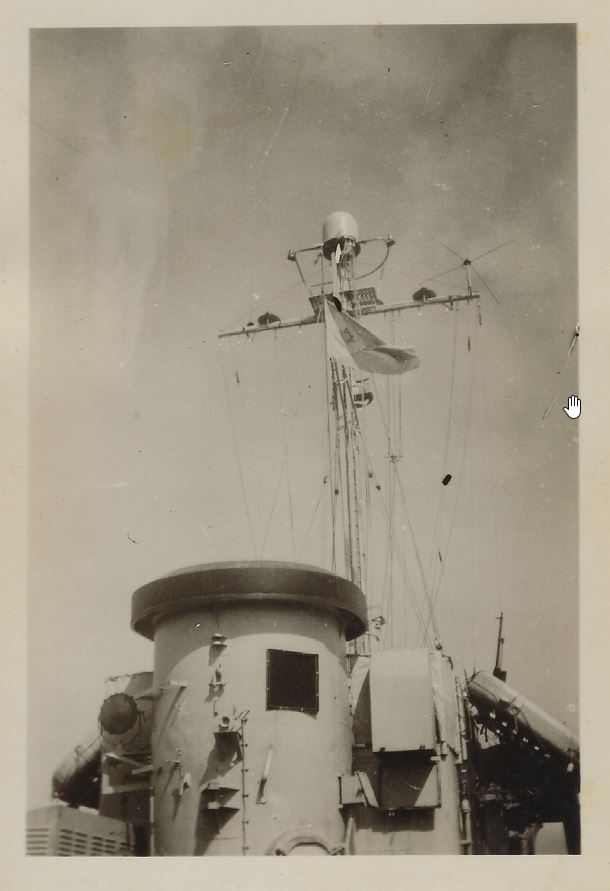
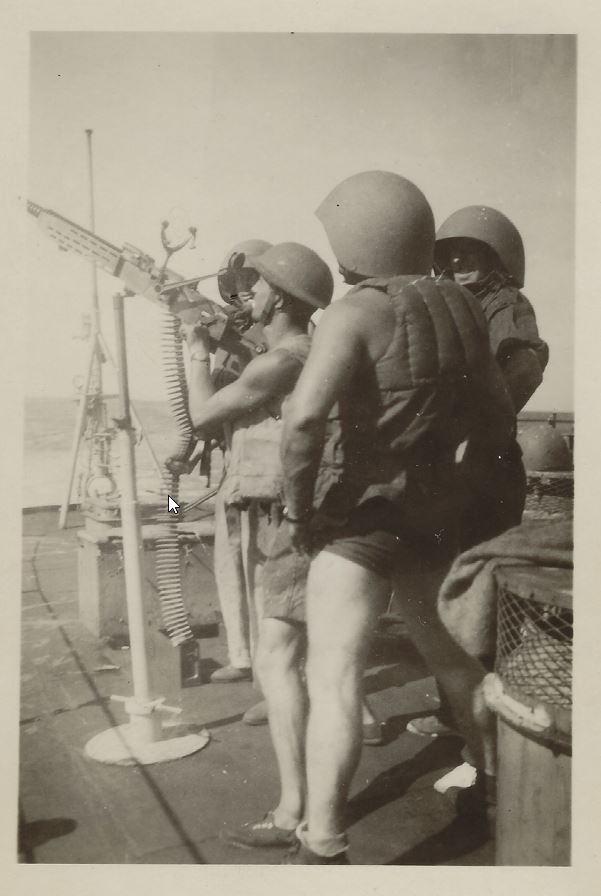
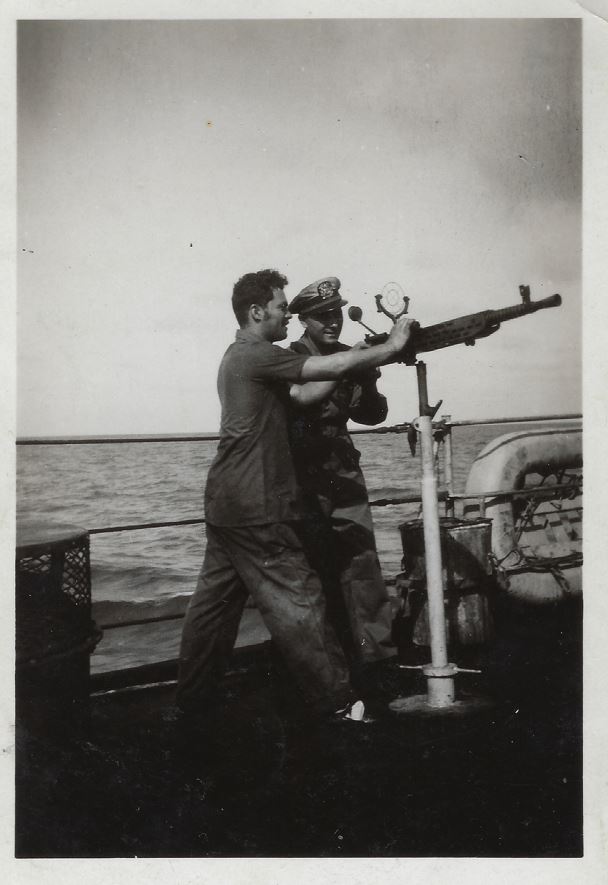
In these pictures we can see US Naval Reserve Commander Benjamin Halpern wearing his US Naval hat.
